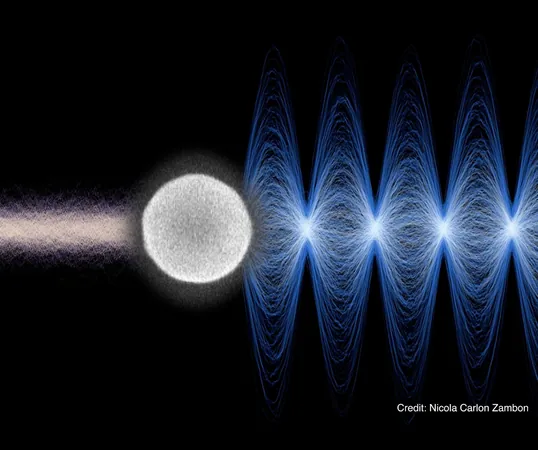
Quantum Leap: Physicists Unveil Game-Changing Technique for Expanding Quantum Wavepackets in Nanoparticles
2025-09-09
Author: Wei
Unlocking Quantum Secrets in Larger Particles
In the fascinating realm of quantum mechanics, particles can behave as both tiny specks and flowing waves, thanks to their wave function—a mathematical depiction of their movements and positions. While scientists have successfully explored the wave functions of small particles, tackling larger ones has remained elusive due to their susceptibility to disruptions.
Breakthrough Research from ETH Zurich and Beyond
A groundbreaking study from researchers at ETH Zurich and the Barcelona Institute of Photonic Sciences presents a revolutionary technique that may redefine the study of larger particles' wave functions. Detailed in their paper in Physical Review Letters, the team introduces quantum squeezing—a method to enhance coherence length, allowing the wave-like behavior of levitated nanoparticles to be more comprehensible.
Massimiliano Rossi, the study's lead author, explained to Phys.org, "Matter-wave interference is one of the most stunning illustrations of quantum physics. Massive objects can indeed behave like waves, akin to ripples on a water surface!" He highlights nanoparticles, comparable in size to viruses, as perfect candidates to showcase this behavior when isolated from their environments.
The Quest for Interference Knowledge
Despite years of experimentation focusing on optomechanical levitation, previously witnessing interference in individual nanoparticles has proven difficult. Rossi recalls, "A significant milestone was cooling a nanoparticle to its quantum ground state. The challenge is that its wavepacket is incredibly narrow, making it hard to observe interference unless the diffraction grating is at an equally tiny scale."
Innovative Solutions for Expanding Wavepackets
The team's recent endeavor aimed to enlarge the quantum wavepacket of motion for nanoparticles. Rossi elaborated on their method, noting, "In a harmonic potential, like an optical tweezer, a Gaussian wavepacket remains tightly confined. Yet, by temporarily weakening this potential, we discovered that the wavepacket expands before being recompressed by the trap."
The team perfected their technique by switching back to a tighter trap before recompression occurs, allowing them to achieve an impressive 70 picometer delocalization—more than double the previous coherence length. While still small by diffraction standards, this success lays the groundwork for future interference experiments.
Future Possibilities: Quantum Delocalization With Bigger Objects?
Rossi believes that repeating this process could exponentially increase delocalization, with the potential to match the nanoparticle's own size. If realized, it could lead to significant advancements in matter-wave interference involving larger, macroscopic objects.
Next Steps: Battling Decoherence for Greater Success
Encouragingly, Rossi and his team aim to innovate further by controlling decoherence—current challenges arise primarily from photon scattering by the optical tweezers. Their future plan involves a hybrid levitation approach, combining optical tweezers with electrical quadrupole traps, enabling enhanced confinement with minimal decoherence. This adaptation will escalate their quest to achieve quantum interference with genuinely massive particles, inching closer to unlocking the mysteries of quantum mechanics.




 Brasil (PT)
Brasil (PT)
 Canada (EN)
Canada (EN)
 Chile (ES)
Chile (ES)
 Česko (CS)
Česko (CS)
 대한민국 (KO)
대한민국 (KO)
 España (ES)
España (ES)
 France (FR)
France (FR)
 Hong Kong (EN)
Hong Kong (EN)
 Italia (IT)
Italia (IT)
 日本 (JA)
日本 (JA)
 Magyarország (HU)
Magyarország (HU)
 Norge (NO)
Norge (NO)
 Polska (PL)
Polska (PL)
 Schweiz (DE)
Schweiz (DE)
 Singapore (EN)
Singapore (EN)
 Sverige (SV)
Sverige (SV)
 Suomi (FI)
Suomi (FI)
 Türkiye (TR)
Türkiye (TR)
 الإمارات العربية المتحدة (AR)
الإمارات العربية المتحدة (AR)